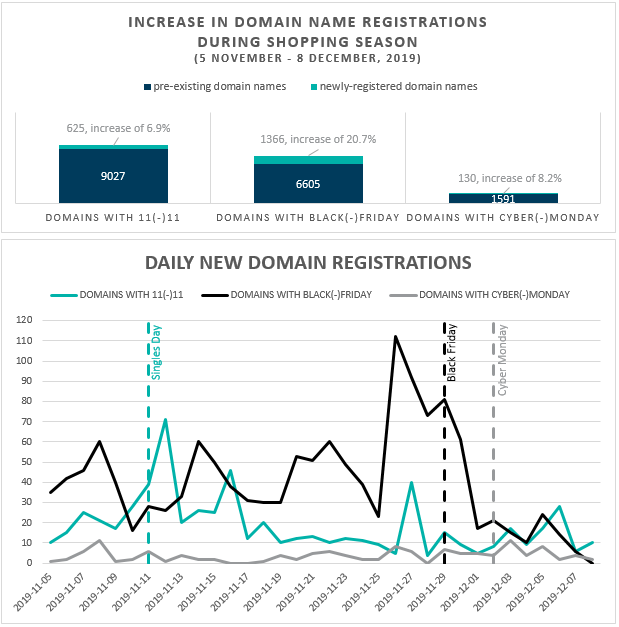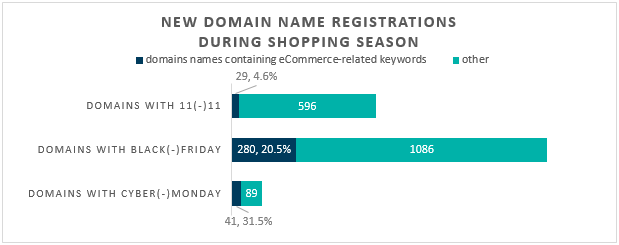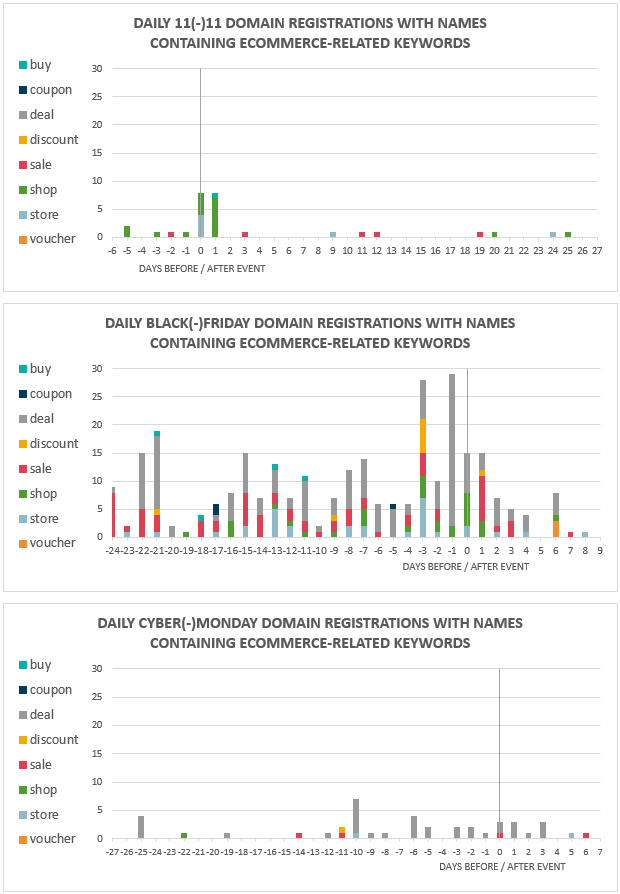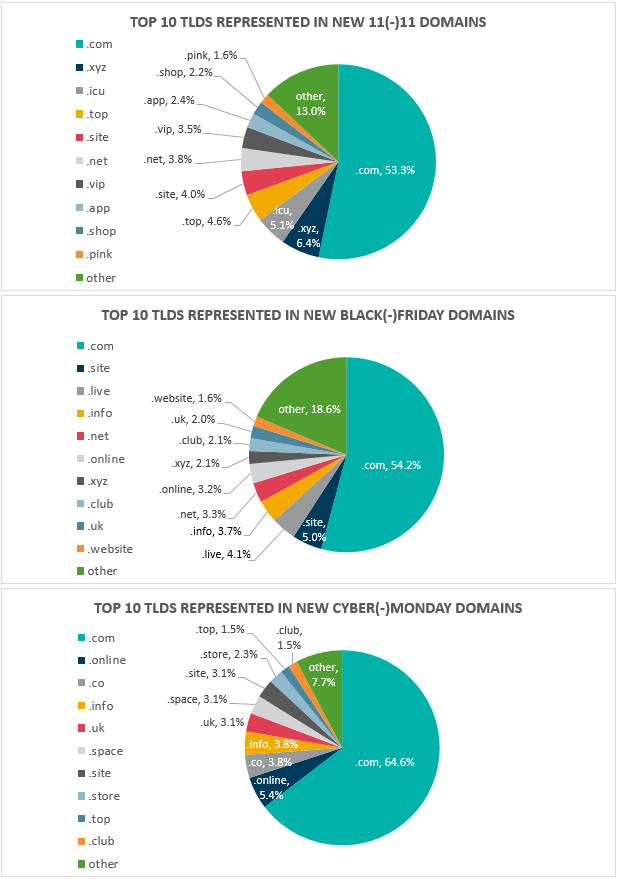By David Barnett
Brand Monitoring subject matter expert Share this post



This is the second in a two-part series of articles looking at domain registrations associated with the 11.11, Black Friday, and Cyber Monday shopping events, following the introductory post published in early November.
During the shopping season, over a period between November 5 and December 8, we monitored the number of new domain registrations with names containing the strings “11(-)11,” “black(-)friday,” and “cyber(-)monday” (with optional hyphens in each case).

We observed considerable activity over the five-week period, with significant increases in the numbers of domains (over 20%, in the case of Black Friday domains) compared to the total pre-existing at the start of the study period. Registrations also peaked close to the actual day of the shopping events, especially for Singles Day and Black Friday.

These data show that significant proportions of the Black Friday and Cyber Monday domains (20.5% and 31.5%, respectively) also feature eCommerce-related keywords in their domain names, suggesting they have been specifically registered to attract web traffic associated with internet users interested in making online purchases across the period. In both cases, the registration activity spanned an extended period of several weeks in the run-up to the events, with the keywords “deal” and “sale” commonly used, as shown below.

A smaller proportion of the 11.11 domains (under 5%) also feature English-language eCommerce keywords. Inspection of the domain names suggests that many of them may not even have been registered with the 11.11 event in mind, and may simply be using “1111” as a generic string.

Similar to the trends seen in the set of pre-existing domains considered in the previous study, .COM continues to account for the majority of new registrations in each of these three cases, though new generic top-level domains, such as .XYZ, .SITE, and .ONLINE are also significant, accounting for notable proportions of the registrations.
Other observations from the sets of newly registered domains
In addition to the domain names including eCommerce-related keywords, many of the event-specific domains registered during the monitoring period also include the names of known and trusted brands, as well as the names of online marketplaces.
While some of these may have been registered by the brand owners to promote their own eCommerce holiday events, a significant proportion certainly were registered by third parties. These individuals may be abusing the brand names to misdirect and monetize web traffic, by diverting users to their own content via re-direction or sponsored advertisements, or by offering the sale of counterfeit items. Amongst the brand names seen to have been used in this way are:
- For 11.11: The eCommerce sites Aliexpress, Tmall, JD, Suning, Gome and Pinduoduo, in addition to Bilibili (a Chinese video sharing site themed around animation and games).
- For Black Friday: Amazon (including a range of mis-spellings), eBay, Paypal, Walmart, Apple (and iPhone), Netflix, Louis Vuitton, Hermes, Dr. Martens, Ugg, Uber, Ford, Toyota, Jeep and Sonos.
- For Cyber Monday: Walmart and Ugg (as also seen for the Black Friday domains), and Macy’s.
There’s also a suggestion that some of the 11(-)11 domains have been specifically registered with a Chinese-speaking audience in mind. These include examples making use of the keywords “guanggunjie” (the Chinese name for Singles Day), “mai” (the Chinese word for “buy” or “sell,” depending on the intonation), and “xianyu,” the name of the Chinese-language sub-platform on the Taobao marketplace offering the sale of used goods.
Some of the identified sites appear to be non-infringing, and resolve either to generic stand alone eCommerce sites, or content relating to the brand owner’s own products or services. In these cases, the owners of the domains appear simply to be taking advantage of the buzz surrounding the holiday shopping events to drive web traffic to their own content.
Other sites feature links to third-party sites, such as examples that aggregate marketplace listings, and then link through to the official marketplace, to generate affiliate revenue from visitor clicks. Other domains were found to resolve to coupon or deal sites. These examples may also be of interest to brand owners, since it may be unclear whether the offer is being made by the referring site itself or by the brand in question. There is also a risk that these sites may collect customer information for their own use before forwarding the user on the to the official brand website.
However, a number of more egregious types of content were also identified. These include:
- Sites offering the sale of branded goods, which may be counterfeit. These examples may be particularly concerning, and misleading to customers, if the domain name includes the name of the brand being infringed.
- Domain names including the names of trusted brands, but which resolve to unrelated third-party sites, which in many cases feature eCommerce-related content.
Key takeaways
Across the period surrounding the 11.11, Black Friday, and Cyber Monday holiday shopping events, significant activity associated with the registration of directly-relevant domain names was identified. Much of this activity is legitimate, and the period does provide an opportunity for brand owners to take advantage of increased web traffic and event-specific web searches by internet users to promote their own goods and services. However, the increased activity also provides opportunities for unscrupulous infringers to abuse the names of trusted brands to drive visitors to their own content, or to sell counterfeit products.
The findings highlight the importance for brand owners not only to protect their intellectual properly defensively, through the registration of a strategic domain portfolio, but also to proactively monitor for activity by third parties, to allow enforcement action to be taken as appropriate. The range of content types seen, and the keywords and top-level domains used, illustrate the requirement for this process to take as holistic an approach as possible.
We’re ready to talk
>> Contact us if you’d like to discuss your brand protection strategy.